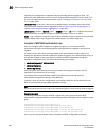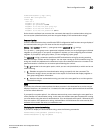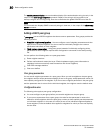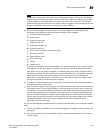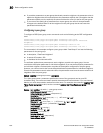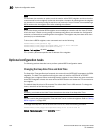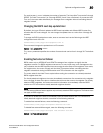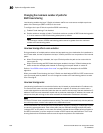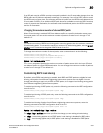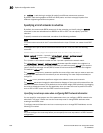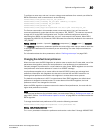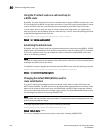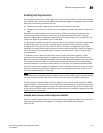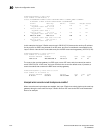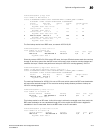
1006 PowerConnect B-Series FCX Configuration Guide
53-1002266-01
Optional configuration tasks
30
Changing the maximum number of paths for
BGP4 load sharing
Load sharing enables the Layer 3 Switch to balance traffic to a route across multiple equal-cost
paths of the same type (EBGP or IBGP) for the route.
To configure the Layer 3 Switch to perform BGP4 load sharing:
• Enable IP load sharing if it is disabled.
• Set the maximum number of paths. The default maximum number of BGP4 load sharing paths
is 1, which means no BGP4 load sharing takes place by default.
NOTE
The maximum number of BGP4 load sharing paths cannot be greater than the maximum
number of IP load sharing paths.
How load sharing affects route selection
During evaluation of multiple paths to select the best path to a given destination for installment in
the IP route table, the last comparison the Layer 3 Switch performs is a comparison of the internal
paths:
• When IP load sharing is disabled, the Layer 3 Switch prefers the path to the router with the
lower router ID.
• When IP load sharing and BGP4 load sharing are enabled, the Layer 3 Switch balances the
traffic across the multiple paths instead of choosing just one path based on router ID.
Refer to “How BGP4 selects a path for a route” on page 983 for a description of the BGP4
algorithm.
When you enable IP load sharing, the Layer 3 Switch can load balance BGP4 or OSPF routes across
up to four equal paths by default. You can change the number of IP load sharing paths to a value
from 2 through 6.
How load sharing works
Load sharing is performed in round-robin fashion and is based on the destination IP address only.
The first time the router receives a packet destined for a specific IP address, the router uses a
round-robin algorithm to select the path that was not used for the last newly learned destination IP
address. Once the router associates a path with a particular destination IP address, the router will
always use that path as long as the router contains the destination IP address in its cache.
NOTE
The Layer 3 Switch does not perform source routing. The router is concerned only with the paths to
the next-hop routers, not the entire paths to the destination hosts.
A BGP4 destination can be learned from multiple BGP4 neighbors, leading to multiple BGP4 paths
to reach the same destination. Each of the paths may be reachable through multiple IGP paths
(multiple OSPF or RIP paths). In this case, the software installs all the multiple equal-cost paths in
the BGP4 route table, up to the maximum number of BGP4 equal-cost paths allowed. The IP load
sharing feature then distributes traffic across the equal-cost paths to the destination.



